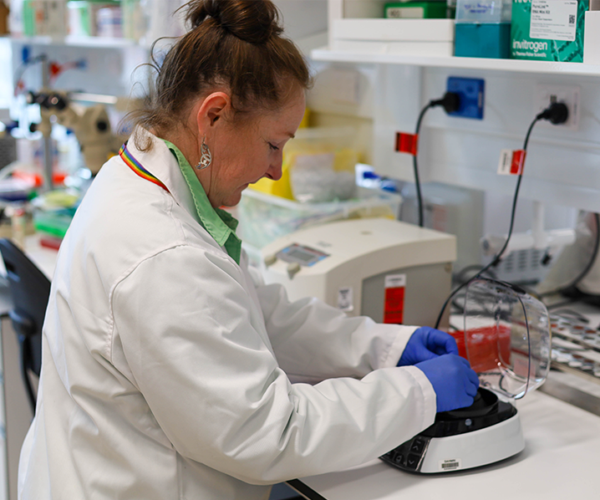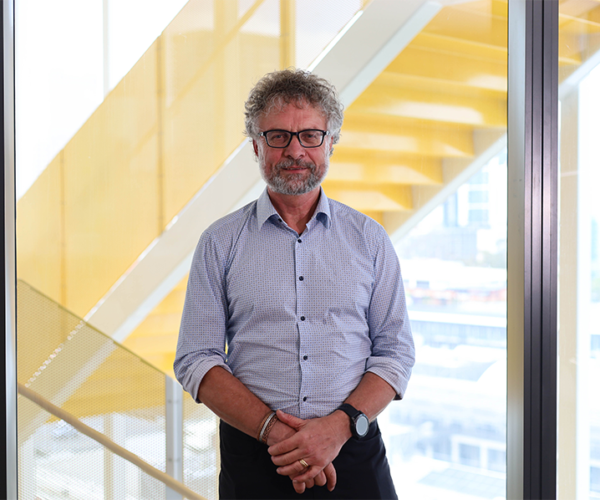Thanks to our partnership with Cops for Kids, we’ve recently supported the expansion of the Women’s and Children’s Hospital’s sleep laboratory study service to allow for in-home sleep studies.
Funding was provided for two new sleep study devices, consumables and set-up costs. The Women’s and Children’s Hospital has the only public polysomnography (sleep study) service available to children in South Australia, and is in high demand, with often long waitlists.
Patients 12 years of age and above experiencing breathing problems during sleep can now undergo their sleep study from the comfort of their own home, reducing wait times and affecting change in their treatments more efficiently.
How it works
Dr John Wong is a respiratory and sleep consultant at the Women’s and Children’s Hospital.
He explains, “A home sleep study is a modified version of the hospital sleep study.”
“Families come to hospital with their child, get set up by one of our technicians and go home to have the study done. The family come back the following day to return the equipment which allows the data to be downloaded and analyzed.”
“One of the main issues that we’ve had in our service is the waiting lists for in-hospital sleep studies. We have used this home-based sleep study as another avenue to relieve the pressure for in-hospital sleep studies. Whilst it’s only at its infancy stage, it looks like we’re starting to get some really encouraging results.”
Through these encouraging results, the respiratory and sleep team are making a real difference in the day-to-day lives of teenagers.
Dr Wong says, “One of the common breathing conditions that we look for is obstructive sleep apnea. In addition to medical complications, we know that obstructive sleep apnea can affect daytime functioning and learning. If we identify obstructive sleep apnea sooner, we can start treatment for it, that may help the teenagers to function better during the day.”
With the home sleep studies that have already been conducted, we are already seeing positive changes in management of patients due to how quickly we are able to get results.
Dr Wong says, “One patient had extremely abnormal breathing when he had his initial in-hospital study, probably one of the worst I’ve ever seen. He underwent treatment, and therapy for it.”
“If he were to wait for another in-hospital sleep study to check his progress, he could be waiting one to two years. Instead, we were able to get him in for a home sleep study, and the results were fantastic. We were able to reduce treatment for him. If we hadn’t had a home sleep study, he may be still on intensive treatment for a year or two.”
Affecting change
15-year-old Boohra Singh (pictured above with his mum, Raminder) was one of the first patients to undergo one of these home sleep studies.
Raminder explains that her son began experiencing breathing problems after contracting COVID, made more severe due to his lowered immunity because of his Crohn’s disease.
She says, “He started snoring at night. I felt like he was not breathing properly, he was having very long pauses. I was very worried, I couldn’t sleep.”
“I got a referral from my GP to see a sleep specialist. Dr Wong first did an in-hospital sleep study, and the results were bad. The doctor called us immediately, and we went to emergency. They started CPAP (continuous positive airway pressure – a common treatment for obstructive sleep apnea) as soon as possible.”
“After the CPAP, his result was very good. He started to sleep well. We then we got a nasal operation, and he got a little bit better.”
Boohra Singh then needed another sleep study, and was a perfect candidate for the new in-home approach.
Raminder says, “Dr Wong called us again and discussed if a home sleep study would be okay. I was very scared for my son, but after surgery and everything, I felt a little bit okay, and Dr, John Wong is a great doctor. He said to me that everything will be fine if we try to do a home sleep study.”
“When we went there, the nurses attended very well to Boohra. They explained every single thing that I had doubts about. They gave me all the answers, with examples and everything. They even said I can call in the middle of the night if I’m not sure what to do.”
Raminder and Boohra Singh were so pleased with the experience, and have already noticed significant improvements in his health.
Raminder says, “I think the home sleep study is very good. It’s very easy and we don’t need to spend the whole night in hospital.”
“It’s been very helpful. He’s not using a CPAP machine now. He’s not pausing his breath at night. And now he’s healthy. He can do whatever he wants. He can run, no problem. He’s good in class too, and not sleepy now in the morning.”
Dr Wong says, “We are so appreciative of the WCH Foundation for all their support, because it’s not just a reduction to our waiting list, but it does affect change for the patients that we’ve seen so far.”
“The hope is that this will be a sustainable option for children and teenagers who would otherwise have to wait for an inpatient service.”




